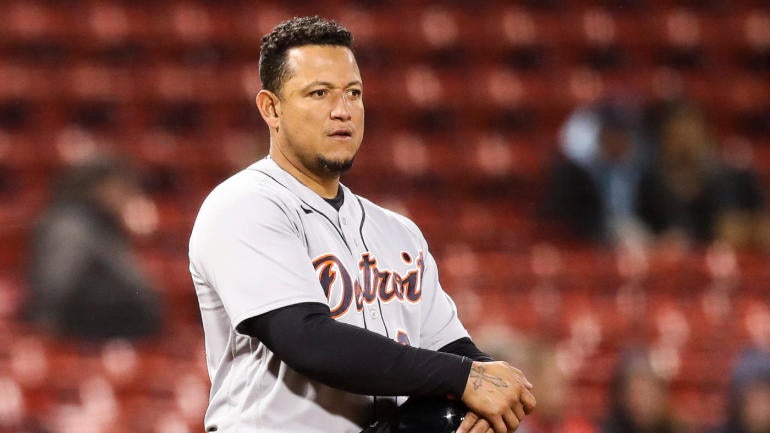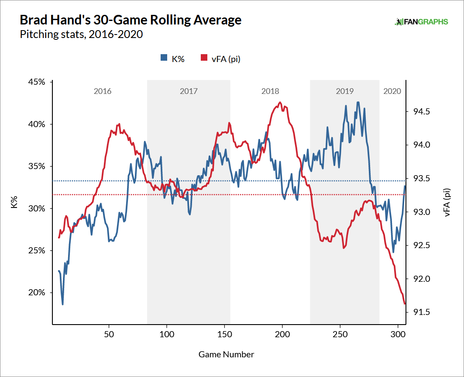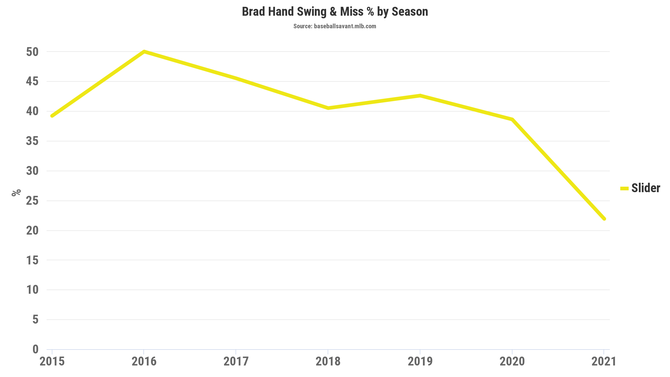
The 2021 MLB regular season is roughly six weeks old and things are starting to look normal. For example, there are no longer any qualified batters hitting over .400. We are averaging a no-hitter a week though, which is decidedly not normal. Even with base hits as hard to come by as any point since the mound was lowered, that no-hitter pace won't continue.
Our weekly series breaking down various trends across the league continues with a look at future Hall of Famer nearing the end of the line, a struggling closer, and the most perfectly average MLB team. Last week we examined Shohei Ohtani's two-way brilliance, an obscure Athletics record, and the death of the hitter's count.
Cabrera limping to milestones
When the Angels cut ties with Albert Pujols last week, it was hard not to think fellow future Hall of Famer Miguel Cabrera could be headed for a similar fate with the Detroit Tigers. Cabrera turned 38 last month and he has been a league average hitter the last four seasons (100 OPS+ from 2017-20), and he's performing well below that level this season:
- Batting average: .141 (10 hits in 71 at-bats)
- On-base percentage: .247
- Slugging percentage: .239 (two homers and 17 total bases in 71 at-bats)
- OPS+: 41
Based on his contact quality (exit velocity, etc.), Statcast estimates Cabrera should be hitting .161 with a .322 slugging percentage right now, which is only a tick better than his actual production. Translation: Miggy's numbers are mostly deserved. He's not hitting into bad luck. His days as an MVP-caliber hitter are long over. It's unclear whether he can even be an average hitter now.
Cabrera's sharp decline comes as he's chasing significant history. He is currently 124 hits away from 3,000 and 11 home runs away from 500, and no player has reached both milestones in the same season. Only six players have reached both milestones period: Pujols, Hank Aaron, Alex Rodriguez, Willie Mays, Rafael Palmeiro, and Eddie Murray.
Detroit has 127 games remaining this season, so Cabrera needs to hit at a 14-homer pace and a 158-hit pace the rest of the way to reach the two milestones. He hasn't hit 14 homers in a full season since 2017 (he did have 10 in 57 games last year) and he hasn't managed a 158-hit season since 2016 (last year's pace was 145 hits). Getting the milestones this year will be a challenge.
Cabrera has three things going for him that Pujols did not. One, the Angels are trying to contend and they could better use Pujols' roster spot on another player. Cabrera isn't blocking a prospect (2020 No. 1 pick Spencer Torkelson has been playing third base in the minors this year) and his decline helps their rebuilding effort when you think about it.
Two, Cabrera is under contract through 2023. Releasing the player in the final year of his contract, like the Angels and Pujols, is an easier pill to swallow than releasing a guy with multiple years remaining. Cabrera is owed the rest of his $30 million salary this year, plus another $32 million in each of the next two seasons. Hard to see the Tigers eating roughly $90 million.
And three, the milestones! Pujols is closing in on some milestones too, though 3,000 hits and 500 home runs are revered. Pujols got those a long time ago and the chase for, say, 3,320 hits (passing Paul Molitor for 10th all-time) isn't quite as historic. Cabrera chasing 3,000 hits and 500 homers will get attention and put butts in the seats, especially since they're happening simultaneously.
Given his contract, it's way too early to begin the "when will the Tigers release Cabrera?" watch, though the Pujols move shows that is likely how this story ends. The more pressing matter right now is whether Cabrera can reach 3,000 hits and 500 homers this year. He came into the season needing 114 hits and 13 homers, and that seemed very doable. Now, six weeks into the season, it's fair to wonder whether Cabrera can get there with 127 games to play.
Hand's missing strikeouts
Since landing in San Diego as a waiver claim in 2016, Brad Hand has been among the top relievers in baseball. He tossed 320 innings with a 2.70 ERA and 434 strikeouts from 2016-20, and was top five in WAR among relievers. Hand was excellent last season too, throwing 22 innings with a 2.05 ERA and 29 strikeouts.
There were worrisome underlying trends, however, which led to Cleveland putting Hand through waivers -- they were unable to find a trade partner for his $10 million club option and hoped a team would claim him so they could avoid his $1 million buyout -- and Hand settling for a one-year, $10.5 million contract with the Washington Nationals on Jan. 29.
Things worked out for Hand -- he made out with $11.5 million between the Nationals contract and option buyout rather than the $10 million he would've made through the club option -- but the fact one of the game's top relievers had no trade value and had to take a one-year deal was telling. Teams were worried about his declining velocity and strikeout rate.

The good news: Hand's fastball velocity is up early in 2021. His heater is averaging 92.2 mph this year, up from 91.4 mph last year. The bad news: pretty much everything else despite a shiny 1.59 ERA. Hand's strikeouts are way down and his walks are way up, and Statcast says his actual slugging percentage allowed is 70 below expected based on the quality of the contact he's given up.
Hand's issues putting hitters away resulted in a messy weekend against the Yankees. He allowed the game-tying run in the ninth and tenth innings Saturday, then took the loss after entering the ninth inning of a tie game Sunday. On Saturday, Hand allowed the game-tying single to Quad-A first baseman Mike Ford, and on Sunday he walked light-hitting utility infielder Tyler Wade on four pitches to leadoff the inning and begin the rally. That's a big no-no.
"These past two days, I've really just kind of beat myself, giving up the free baserunners there to begin the inning," Hand told reporters, including the Associated Press, after blowing two leads Saturday and taking a loss Sunday. "You just can't keep falling behind hitters like that."
Hand threw 46 pitches Saturday and Sunday and generated only three swings and misses. His 9.0 percent swing-and-miss rate is well below the 11.5 percent league average and down from 10.5 percent last year. Nine strikeouts and seven walks in 11 1/3 innings is not going to cut it for a high-leverage reliever. This is especially worrisome:

For all the focus on his fastball velocity, the swing-and-miss rate on Hand's slider this year is about half what it was last year (and during his peak). He's thrown roughly 50/50 fastballs and sliders the last few years, and he was able to survive the fastball velocity decline because his slider is so good. This year though, the slider has been a mediocre pitch.
Hand has gone through ups and down at various points the last few years (which reliever doesn't?), though never has his slider generated this few empty swings, even in a sample this small. Even though his fastball has bounced back, it's possible last year's velocity loss was an indication there's something bad going on under the hood, like an injury or mechanical issues.
I won't declare Hand done as a top-flight reliever after a dozen or so innings. I don't think we can simply chalk up his strikeout (and walk) issues to sample size noise, however. Not when it's part of a multi-year trend. Hand without his slider is rather ordinary. I'm not worried about him yet. This does have my attention though. This appears to be more than a blip.
The almost perfectly average Rangers
Six weeks into the 2021 season, things are going about as well as the Texas Rangers could've possibly hoped. Kyle Gibson has been out of this world good since his Opening Day meltdown, Nate Lowe and Nick Solak are cementing themselves as the long-term future on the right side of the infield, and Adolis Garcia ranks among the league leaders in home runs.
This was supposed to be a rebuilding season for the Rangers (it still is a rebuilding season, really) yet they come into Wednesday on the fringes of the postseason race (it's super early, I know). Texas has been about as average as it gets:
- 99 OPS+ as a team (100 is average)
- 104 ERA+ as a team (100 is average)
- -2 Defensive Runs Saved (0 is average)
- 42 percent extra base taken rate (41 percent is average)
Almost perfectly average across the board, and prior to getting swept by the Giants this week, the Rangers were 18-18 with a minus-4 run differential. That's pretty darn close to average too. Heck, their current 18-20 record and minus-8 run differential is still very close to average. This team has been league average personified.
The Rangers haven't been great at anything, but they haven't been bad at anything either. They've been competent in all phases of the game, and I'm a firm believer that players or teams who are average at everything are above-average overall. There's a lot of value in having no weakness and, to date, Texas has shown no obvious weakness.
Of course, there is still a lot of season to be played, and being close to average to date does not mean the Rangers will be close to average the rest of the season. Their performance to date describes what they've done in the past, not predict what they'll do in the future. Since this is a rebuilding year, I'd bet on Texas being a below-average team the rest of the way.
The next two weeks will be a good measuring stick. The Rangers were just swept in two games in San Francisco by the first-place Giants, and their next 10 games are against the Astros and Yankees, arguably the two most talented teams in the league. If the Rangers comes out of that stretch with their head above water, then maybe we should view the rebuild as ahead of schedule.






















